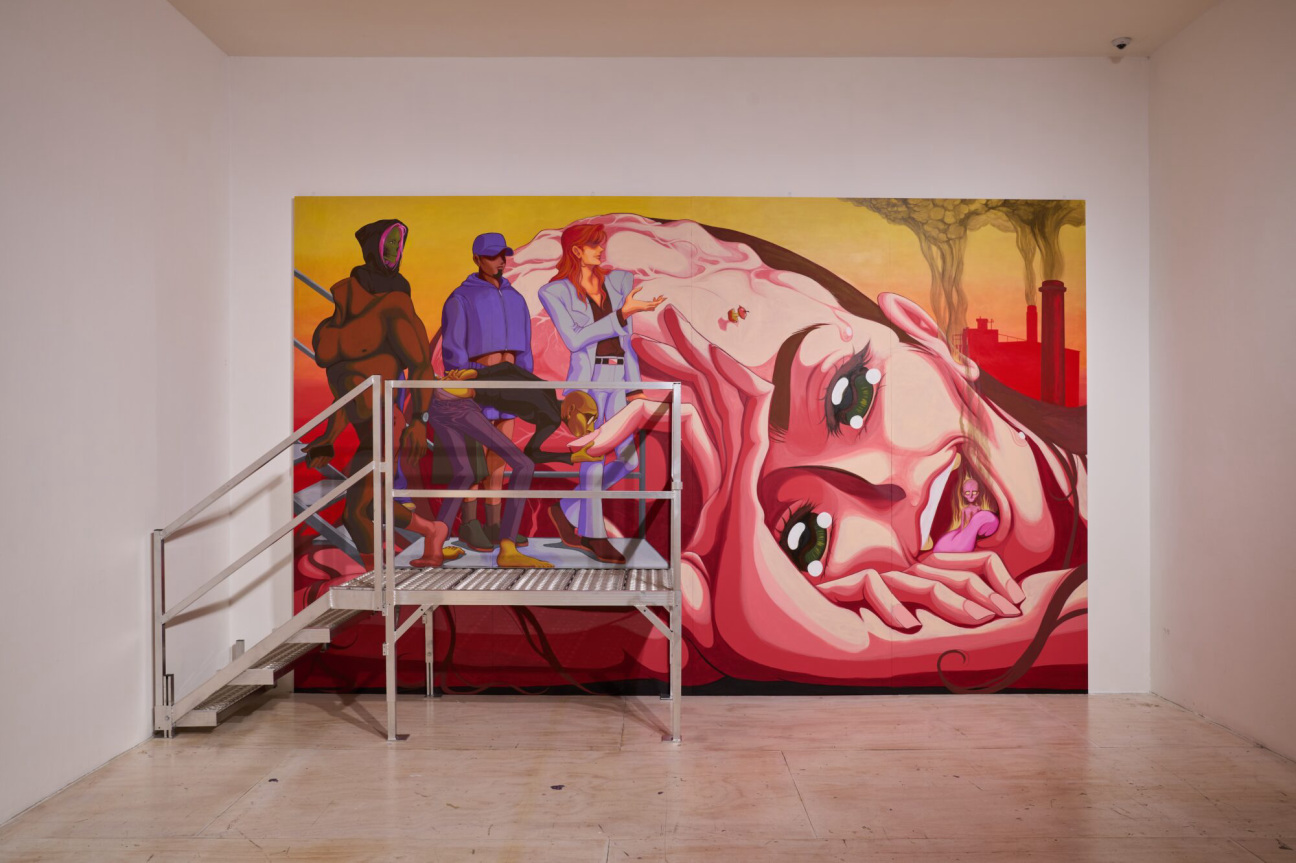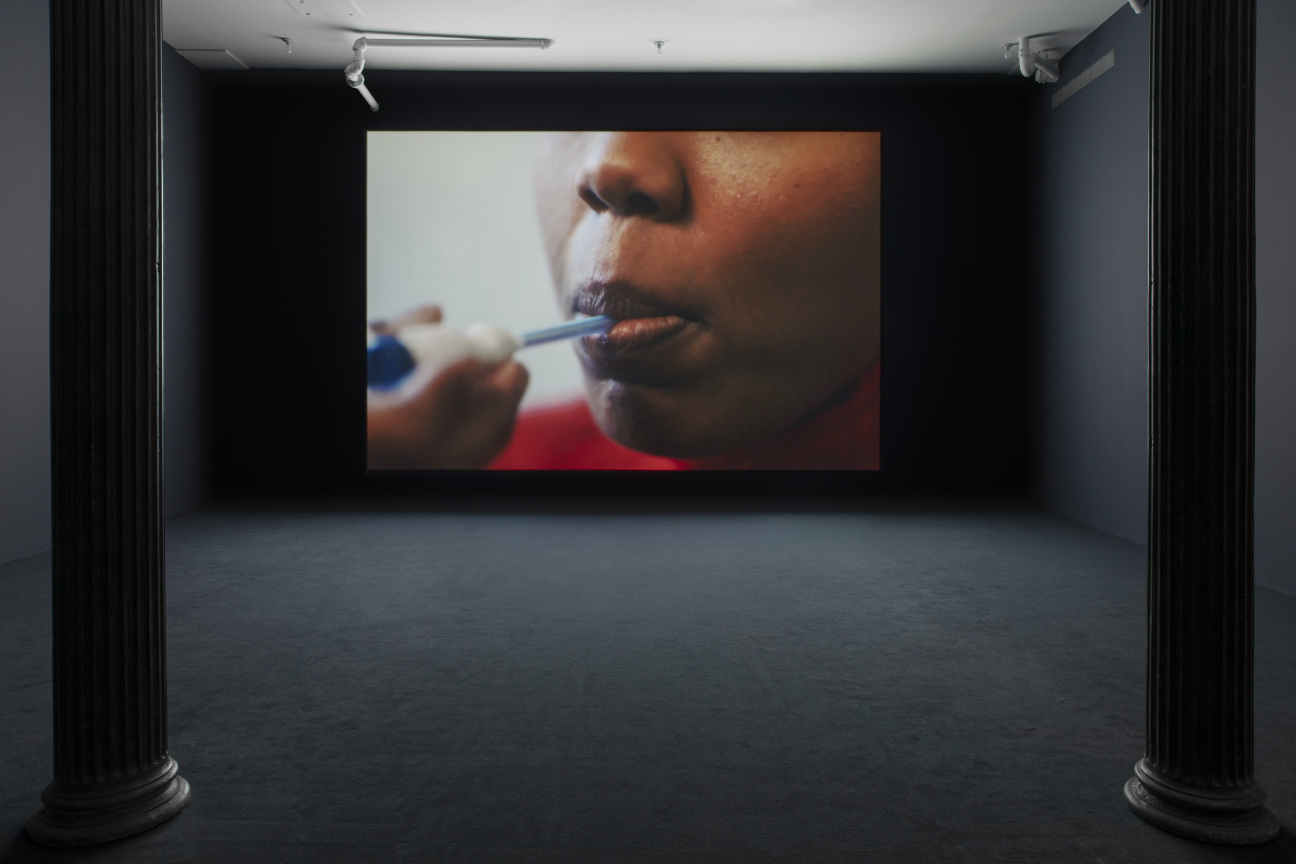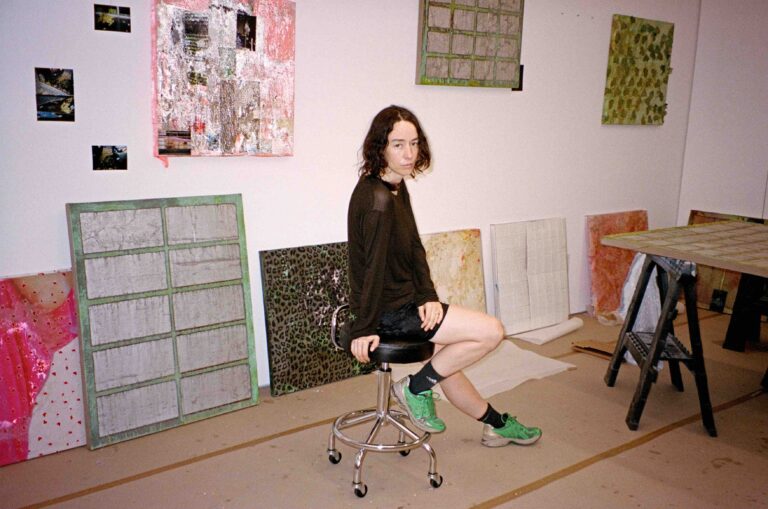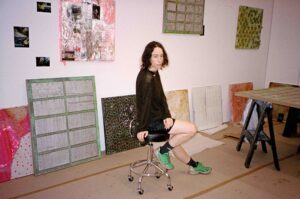
Julien Ceccaldi
MoMA PS1 | 22-25 Jackson Ave, Queens
Through August 25, 2025
For his first American institutional exhibition “Adult Theater,” Julien Ceccaldi brings his shōjo manga-inflected drawings, paintings, and reanimated comics to MoMA PS1 in an installation that hints at a fitting development for his practice: social realism. The acrylic wall panels of the mural-scale painting A Collection of Little Memories, 2025, which comes with a set of aluminum stairs, on which one of the work’s muscular figures appears to be walking down (via a trompe l’oeil trick), seems like a perverse take on the genre. The painting depicts the balding noggin of Francis—a recurring character in the artist’s stable—whose comically agape mouth emits a dark plume identical to those of the smokestacks in the background, while generically clad suitors line up to delicately kiss one of his nails (submissive), or toss out their apple core onto him (kingly dom).
Though sly social commentary was a light theme of his already, it becomes clearer here that Ceccaldi’s work is most compelling when it takes cues from an older genre to send up the contemporary pageantry of hopers, wishers, and strivers modeling themselves as romantic lead characters—or, at least, as the most desirable bod at the baths, per another large painting on plywood, titled Pompeii Bathhouse, 2017. Vitrines of drawings provide an endearing glimpse at process—three Post-its serve as quick character sketches—but a room dedicated to presenting lightly animated versions of Ceccaldi’s older comics is the more vivacious area of this compact show. With a style of movement mostly based on panning over still frames, the saucy dialogues proffer quotable one-liners, such as, “Preventing people from knowing who I really am feels incredible!” All are called to be caricatures of themselves instead.—Paige K. Bradley

Elle Pérez
Arts & Letters | Audubon Terrace between West 155 & 156th Streets
Through July 3, 2025
Elle Pérez’s subject matter spirals outward from their social world. A formal sensibility forged in the Bronx punk scene of their teen years and the visual language of a particular queer subculture maintains its ethics of exchange, connection, and looking—even when the artist wanders much farther afield with their camera, to, say, Monet’s garden in Giverny. “The World Is Always Again Beginning, History with the Present” is an abbreviated overview of their practice (which includes text, collage, and film, as well as photography), spanning 2009 to 2025. Arranged associatively within chronological categories, the airy presentation at Arts & Letters doesn’t belabor the through line of distinct eras: The wall text, composed of Pérez’s own poetry, is fragmentary and oblique, reflecting a cross-medium penchant for synecdoche.
Portraiture is central throughout, perhaps especially to the earliest photos on view, with judicious details—a tattered Tyvek wristband, a wallet chain—speaking volumes about Pérez’s young subjects. An archival impulse to document faces and friendships suffuses these images—though not at the expense of a sense of place. One of the most striking black-and-white pictures on view in the first gallery shows a small, empty stage with an American flag backdrop, a drumstick, and a water bottle suggesting just-transpired action. These images of a local punk scene segue into others shot at entertainment wrestling events in 2013, also in the Bronx (a world Pérez gained entrance to via a cousin).
The third gallery contains a breathtaking new series of larger prints, “La Despedida,” 2025, which pairs two distant gardens: the aforementioned site of the French Impressionist’s lily pond and Pérez’s grandfather’s yard in Puerto Rico. Vastly different landscapes seem to merge in moments, becoming a single, continuous, sun-dappled source of artistic sustenance—though the nearby portrait Pedro in His Garden, 2012/2025, illuminates Pérez’s deeper history with one of them.—Johanna Fateman

Carolyn Lazard
Artists Space | 11 Cortlandt Alley
Through May 10, 2025
At a time when reproductive rights are under attack in the U.S., and egregiously high Black maternal mortality rates illuminate dire inequalities in healthcare, Carolyn Lazard centers Black patients and workers with a pair of taut, unsettling videos on birth-related care in their exhibition “Two-way” at Artists Space. The Philadelphia- and New York-based artist filmed both works in a Queens hospital’s “simulation center”—a set-like facility for employee training. Despite the shared setting, Lazard’s videos offer contrasting perspectives on some of the most intimate and vulnerable moments of pregnancy and birth. In one, a pregnant patient, dehumanized by the healthcare system, navigates their first prenatal checkup; in the other, an all-Black medical team practices birthing techniques on a nonhuman surrogate—a mannequin with brown skin named Jayda.
A deceptively banal procedural, the 16-minute Vital, 2025, ultimately proves as fraught as the sensationalized soap opera playing on the waiting-room television in the video. The main character, a 34-year-old artist named Maxine (played by the artist-filmmaker Martine Syms), finds their search for care thwarted at every turn. Their regular OB-GYN is inexplicably absent for this important appointment and the substitute (actor and writer Cyrus Dunham) is inattentive and unsympathetic to their concerns. His dispassionate remove mirrors that of the healthcare industry at large: After the visit, Maxine learns their insurance coverage has been denied without explanation. Lazard’s restrained script repeatedly demonstrates how opacity is employed to maintain hierarchy, keeping the patient in the dark about their own well-being. As the film seamlessly loops, Maxine appears fated to endlessly wander the hospital’s empty corridors in a quest for something resembling care.
The Black birthing team in Fiction Contract represents a more positive vision (though the workers perform under surveillance). Within the video’s frenetic but stilted action, doctors, midwives, nurses, and administrators roleplay emotional support as much as they practice maneuvers to reposition the baby during a “complex childbirth scenario.” The patient, Jayda—via piped-in audio—expresses fear, discomfort, and finally relief: “I can’t believe it, I’m a mother,” she says. In the end, the successful “birth” feels eerily unresolved given the blankness of the dolls. But the camera lingers on the pair long enough to show the swaddling blanket rising and falling as if from breathing, reminding viewers of the very real implications of the exercise.—Chris Murtha










 in your life?
in your life?